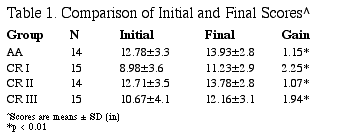| COMPARISON OF ACTIVE ASSISTIVE TO CONTRACT-RELAX STRETCHING L. Kravitz The purpose of this study was to compare the effect of active assistive stretching (AA) and variable time-controlled contract-relax stretching (CR) in improving hip and back extensor range of motion. College female volunteers (n=58, average age = 21.6 yr) were pre-tested in the modified sit-and-reach and then randomly assigned to 4 experimental groups: AA and three CR groups. The AA group performed a sustained assisted forward flexion stretch at the endpoint of movement. CR groups I, II, and III alternated a 6-sec. hip extension contraction with an assisted forward flexion stretch phase of 22, 13, and 6 sec., respectively. All AA and CR stretch bouts were approximately 60 sec. in duration. Prior to training, subjects were familiarized with their specific stretching technique, which was facilitated using a flexibility training device. Three stretch bouts were performed by all groups per treatment after a standardized full-body warm-up. Subjects rested in a seated position for 20 sec. between stretch bouts. Subjects were post-tested in the modified sit-and-reach after a 6-week training period of 2 treatments per week. Significant gains (p<0.01) in flexibility were obtained by all groups. However, ANOCOVA, using pre-test means as the covariate, indicated no significant difference (p>0.05) between groups. Results indicate that AA and CR stretching techniq |
 |
| Research Interests | | Vita | | Articles | | New Projects | | Miscellaneous | | UNM | | Home |